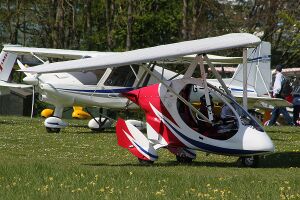Engineering:P&M PulsR
| PulsR | |
|---|---|

| |
| Role | Ultralight trike |
| National origin | United Kingdom |
| Manufacturer | P&M Aviation |
| Designer | Bill Brooks |
| Introduction | 2011 |
| Status | In production (2018) |
| Produced | 2015-present |
The P&M PulsR () is a British ultralight trike, designed by Bill Brooks and produced by P&M Aviation of Rochdale. The aircraft is supplied complete and ready-to-fly.[1]
The design was introduced publicly at the Flying Show in Birmingham in December 2011, where writer Demitri Delemarle reported that it "stole the show", due to its unusual semi-enclosed cockpit design.[1]
Design and development
The PulsR was designed to comply with the Fédération Aéronautique Internationale microlight category, including the category's maximum gross weight of 472.5 kg (1,042 lb) with a ballistic parachute. The aircraft has a maximum gross weight of 472.5 kg (1,042 lb) with a ballistic parachute and 450 kg (992 lb) without.[1]
The design was first shown in 2011 and remained in prototype-only form until 2015.[1]
The aircraft design features a strut-braced topless hang glider-style high-wing, weight-shift controls, a two-seats-in-tandem semi-enclosed cockpit with a cockpit fairing and windshield, tricycle landing gear with main gear wheel pants and a single engine in pusher configuration.[1]
The aircraft fuselage is a monocoque design made from composite carbon fibre, with its double surface wing covered in Dacron sailcloth. Its 9.26 m (30.4 ft) span wing is supported by struts and uses an "A" frame weight-shift control bar, which is routed through the open side window spaces in the semi-enclosed fairing. The powerplant is a four-cylinder, air and liquid-cooled, four-stroke, dual-ignition 100 hp (75 kW) Rotax 912ULS engine.[1][2]
The aircraft has an empty weight of 251 kg (553 lb) and a gross weight of 472.5 kg (1,042 lb), giving a useful load of 222 kg (489 lb). With full fuel of 78 litres (17 imp gal; 21 US gal) the payload is 166 kg (366 lb).[1][2]
Operational history
Writer Demitri Delemarle reports that the design "never fails to attract attention" wherever it is shown, due to its unusual aerodynamic cockpit design, which makes it much faster and gives a better glide ratio than other trikes.[1]
Specifications (PulsR)
Data from Tacke and manufacturer[1][2]
General characteristics
- Crew: one
- Capacity: one passenger
- Length: 3.2 m (10 ft 6 in)
- Wingspan: 9.26 m (30 ft 5 in)
- Height: 2.82 m (9 ft 3 in)
- Wing area: 13 m2 (140 sq ft)
- Empty weight: 251 kg (553 lb) with ballistic parachute fitted
- Gross weight: 472.5 kg (1,042 lb)
- Fuel capacity: 78 litres (17 imp gal; 21 US gal)
- Powerplant: 1 × Rotax 912ULS four cylinder, liquid and air-cooled, four stroke aircraft engine, 75 kW (101 hp)
- Propellers: 3-bladed composite
Performance
- Maximum speed: 169 km/h (105 mph, 91 kn)
- Cruise speed: 153 km/h (95 mph, 83 kn)
- Stall speed: 63 km/h (39 mph, 34 kn)
- Never exceed speed: 190 km/h (120 mph, 100 kn)
- g limits: +6g/-3g (ultimate)
- Maximum glide ratio: 12:1
- Rate of climb: 5.1 m/s (1,000 ft/min)
- Rate of sink: 2.1 m/s (410 ft/min)
- Wing loading: 36.3 kg/m2 (7.4 lb/sq ft)
References
- ↑ 1.0 1.1 1.2 1.3 1.4 1.5 1.6 1.7 1.8 Tacke, Willi; Marino Boric; et al: World Directory of Light Aviation 2015-16, page 236. Flying Pages Europe SARL, 2015. ISSN 1368-485X
- ↑ 2.0 2.1 2.2 P&M Aviation (2014). "PulsR". www.pmaviation.co.uk. http://www.pmaviation.co.uk/pulsr-ouraircraftdetails.html. Retrieved 28 February 2018.
External links
 |

